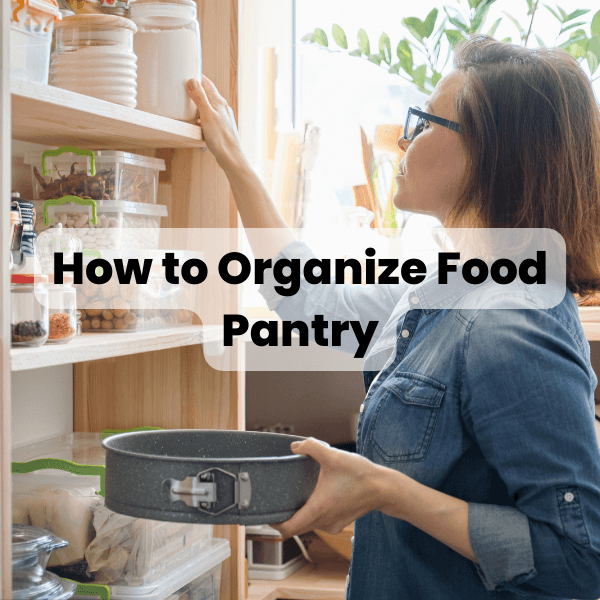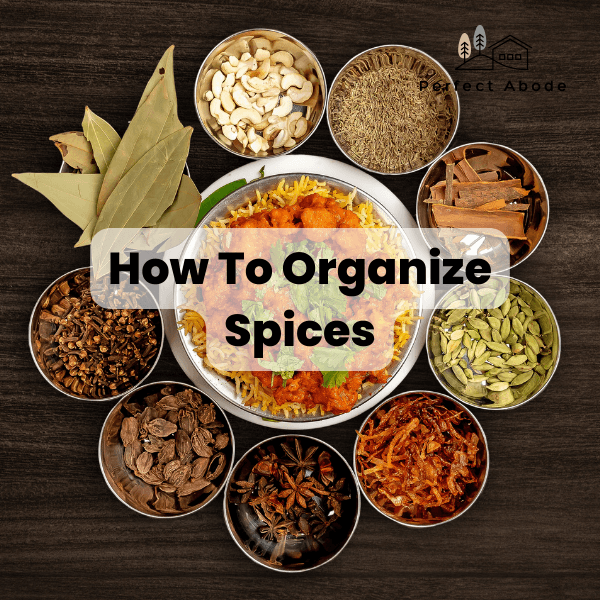How to Organize Food Pantry – The Ultimate Guide
Importance of Organizing a Food Pantry:
Are you tired of rummaging through your pantry to find what you need? Organizing your food pantry is not only about maintaining a tidy space, but it also plays a significant role in ensuring the efficiency and effectiveness of your daily meal preparation. A well-organized food pantry not only saves you time and effort but also prevents food waste and ensures that you have a clear inventory of what you have on hand.
Benefits of a Well-Organized Pantry:
From reducing stress in the kitchen to saving money on groceries, a well-organized food pantry offers numerous benefits. By arranging your pantry logically and systematically, you can easily access ingredients, spices, canned goods, and baking ingredients, making meal planning and cooking a breeze. Additionally, an organized food pantry allows you to keep track of your supplies, so you know exactly what needs to be replenished, avoiding unnecessary purchases and food waste.
Custom Shelving Solutions
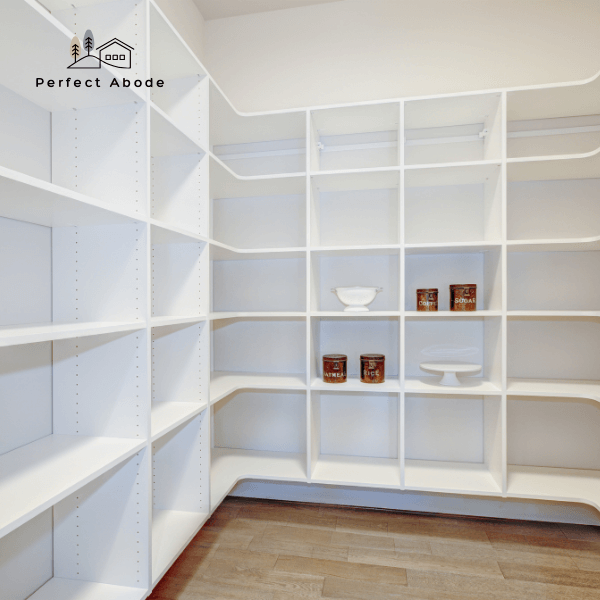
When it comes to pantry organization, custom shelving is a game-changer. The Perfect Abode recommends using materials like plywood and metal pipes for both style and functionality. Explore designs such as floating wire shelves and ladder shelves, and consider incorporating creative lighting options like LED strips to enhance visibility.
Implementation:
- Selecting the Right Material: Opt for materials like plywood or metal pipes for durable and visually appealing custom shelving.
- Choosing the Perfect Design: Explore designs such as floating shelves or ladder shelves that suit your pantry space.
- Illuminating Your Shelves: Enhance visibility and aesthetics with creative lighting options such as LED strips.
Food Storage and Shelf Organization
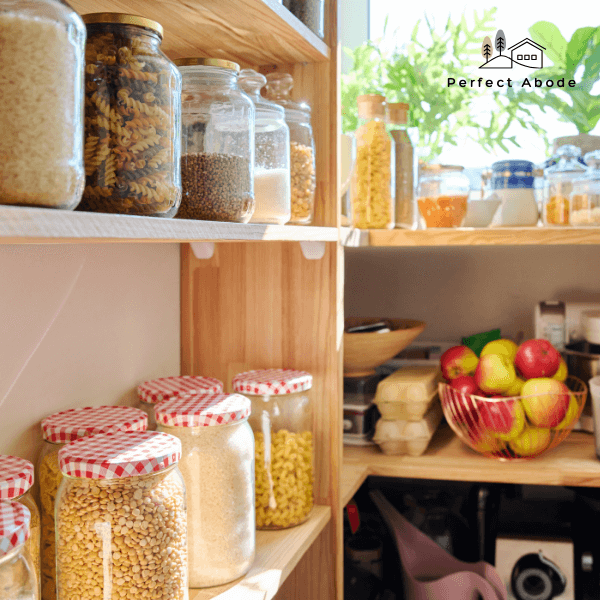
A well-organized food pantry not only facilitates easy access to various food items but also ensures efficient space utilization. Follow these tips to effectively store and organize your pantry:
Categorizing and grouping food items
- Organizing by food groups: Sort your pantry items based on food groups such as grains, canned goods, snacks, etc. This will make it easier to find specific items when needed.
- Grouping similar items: Grouping similar items, such as baking goods, cereal, pasta, etc., within their respective food groups will further streamline the organization process.
Utilizing shelf space efficiently
- Using risers or shelf dividers: Maximize vertical space by using risers or shelf dividers. These allow you to create additional levels, enabling you to store more items without wasting any available space.
- Stacking containers or baskets: Make the most of shelf depth by stacking containers or baskets. This technique allows you to utilize vertical and horizontal space, maximizing the storage capacity of your shelves.
Arranging items for easy accessibility
- Placing frequently used items at eye level: Keep frequently used items within easy reach by placing them at eye level. This way, you won’t have to spend extra time and effort searching for them.
- Keeping heavier items on lower shelves: Maintain stability and prevent accidents by storing heavier items on lower shelves. This ensures that the weight of these items does not strain or topple the shelves.
Follow these food storage and shelf and pantry organization ideas and tips to create a well-structured and easily accessible pantry. By maintaining an organized pantry, you’ll not only save time but also maintain an inventory of available food items more effectively.
Inventory Management

Effective inventory management is crucial for maintaining a well-organized food pantry. By carefully tracking and maintaining a record of food items, rotating stock based on expiration dates, and ensuring a well-stocked pantry, you can maximize the efficiency of your pantry organization. Here are some tips to help you with your inventory management:
Tracking and maintaining a record of food items
- Create an inventory system: Use a spreadsheet or a pantry app to keep track of the food items in your pantry. This will help you easily locate items, monitor quantities, and know when it’s time to restock.
- Label containers or shelves: To quickly identify items, label containers or shelves with their respective names and quantities. This will make it easier to locate specific items and prevent confusion when organizing your pantry.
Rotating stock based on expiration dates
- Implement a FIFO system: Follow the “First In, First Out” rule for perishable items. This means using the oldest items first before moving on to newer ones. This helps minimize food waste and ensures that items are consumed before they expire.
- Regularly check expiration dates: Take the time to inspect your pantry regularly and discard any expired items. Make it a habit to check expiration dates when organizing your pantry to maintain a fresh and safe supply of food.
Ensuring a well-stocked pantry
- Create a shopping list: Based on your inventory and meal plans, create a shopping list to help you stay organized and avoid purchasing unnecessary items. This will also ensure that you have all the necessary ingredients for your meals.
- Stock up on staple items: To avoid running out of essential ingredients, it’s wise to stock up on staple items such as rice, pasta, canned goods, and spices. This will help you maintain a well-stocked pantry and prevent last-minute trips to the store.
Labeling and Labeling Systems
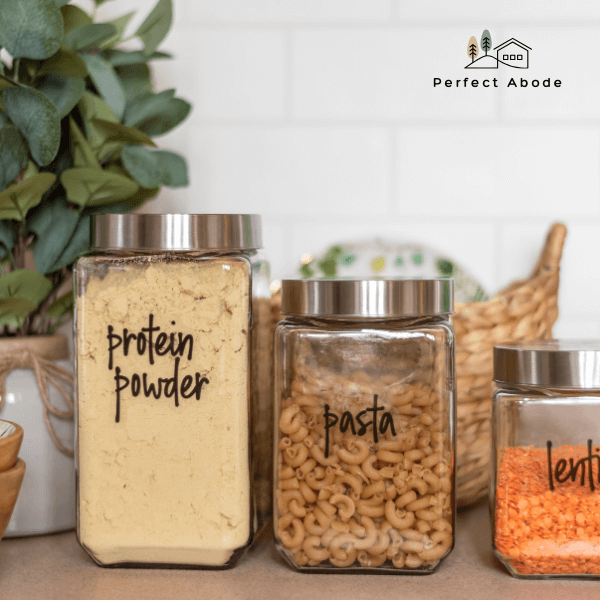
Labeling is an essential part of organizing your food pantry. It helps you keep track of what you have, when it expires, and any dietary information. With accurate labeling, you can easily identify items and ensure nothing goes to waste. In this section, we will discuss the importance of accurate labeling and choosing the right labeling system for your pantry.
Accurate labeling of food items
When labeling your food items, it is crucial to include key information such as expiry dates and dietary information. This ensures that you are aware of which items need to be used first and helps you plan your meals accordingly. Additionally, noting any dietary information or allergens on the labels can be helpful for those with specific dietary needs.
It is also advisable to use clear and waterproof labels to ensure longevity. Pantries and drawers can be prone to moisture and spills, so using waterproof labels will prevent them from fading or peeling off over time. Clear labels make it easier to read the information and eliminate any confusion when looking for a specific item.
Choosing a labeling system
Having a labeling system in place makes it easier to locate items quickly and efficiently. There are two popular methods to consider: color-coding and numbering systems.
- Color-coding: Assigning different colors to specific categories or types of food can streamline the organization process. For example, you can use green labels for vegetables, blue labels for snacks, and red labels for canned goods. This system allows for easy identification and saves time when searching for a particular item.
- Using labels that can be easily removed or replaced: Sometimes, you may need to reorganize your your pantry shelves or change the contents of a labeled container. It is beneficial to use labels that can be easily removed or replaced without leaving sticky residue. This flexibility prevents the need to create new labels each time you rearrange or replace items.
By implementing an accurate labeling system in your pantry, you can maximize efficiency and maintain a well-organized space. Take the time to label your items correctly and choose a system that suits your needs, and you’ll be able to find what you need when you need it.
Space Optimization
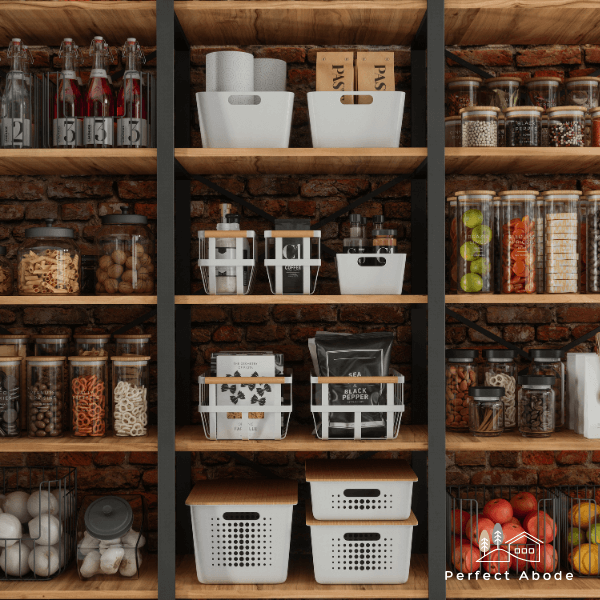
When it comes to organizing your food pantry, optimizing the available space is crucial. By using smart storage solutions small appliances and a well-planned layout, you can make the most of every inch in your pantry.
Maximizing available space in the pantry
1. Utilizing food storage containers and solutions like containers, baskets, and racks
Invest in clear containers, baskets chip bags, and racks to keep your pantry tidy and maximize space. By storing items in designated containers, you can easily stack them and optimize vertical space. Baskets and racks can be used to hold smaller items or cans, ensuring everything has its place.
2. Making use of vertical space with hooks or hanging organizers
Don’t forget about the vertical space in your pantry. Install hooks or hanging organizers on the inside of the pantry door or walls to store items like aprons, reusable bags, or lightweight utensils. This way, you can utilize the otherwise wasted wall space, and keep your pantry free from clutter.
Organized layout for easy access
1. Arranging frequently used items within arm’s reach
When organizing your pantry, consider the frequency of use for each item. Keep frequently used items within arm’s reach to save time and effort. You can accomplish this by putting them in containers that are simple to access or on lower shelves. Items that are less frequently used can be stored on higher shelves or in labeled bins.
2. Keeping similar items together to minimize search time
Grouping similar items is essential for easy access and efficient organization. Keep all baking goods, canned foods, snacks, or spices in their designated areas. By doing so, you’ll minimize search time and have a clear overview of what you have in stock.
Bulk Buying and Storing
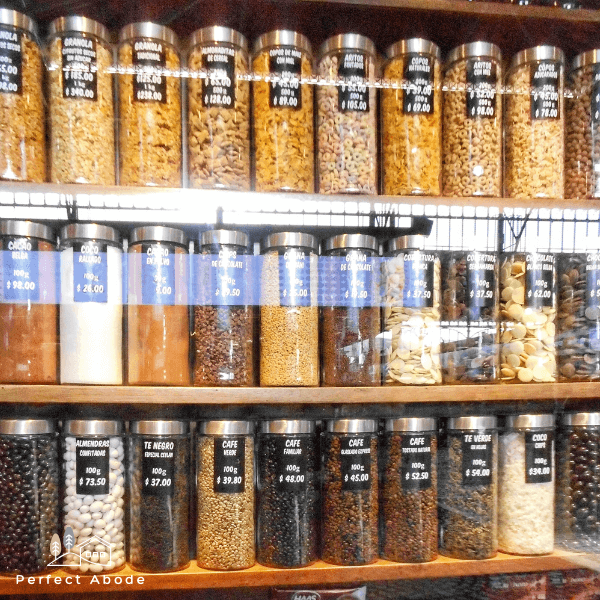
Buying food items in bulk
Buying food items in bulk offers several benefits, including significant cost savings and reducing packaging waste. When you purchase larger quantities of food, you often receive a lower price per unit, allowing you to save money in the long run. Additionally, buying in bulk reduces the amount of packaging waste generated, which is great for the environment.
To make the most of your bulk purchases, it’s essential to ensure proper storage conditions for extended shelf life. By understanding how to store each type of food item correctly, you can maximize its freshness and prevent spoilage.
Using appropriate containers or packaging
Using the right storage containers, or packaging is crucial for maintaining the quality of your bulk food items.
- Airtight containers for perishable items: Fresh produce, dairy products, and meats should be stored in airtight containers to maintain their freshness and prevent contamination. Opt for food-grade plastic containers or glass jars with tight-fitting lids.
- Vacuum-sealed bags or jars for bulk dry goods: Dry goods such as grains, beans, and flour are best stored in vacuum-sealed bags or airtight glass jars. These containers help remove excess air and moisture, preventing spoilage and extending their shelf life.
Properly organizing and labeling your bulk food items will also help you easily locate them when needed, reducing the chances of wasted food and ensuring a well-organized pantry.
Budgeting and Shopping Tips

When it comes to organizing your food pantry, budgeting and smart shopping are key aspects to consider. By effectively managing your expenses and making the most out of your grocery trips, you can maintain a well-stocked and organized pantry without breaking the bank.
How to budget for groceries
1. Establishing a grocery budget and tracking expenses
Start by setting a monthly or weekly grocery budget that works for your household. This will give you a clear idea of how much you can afford to spend on groceries and keep you on track. Make use of budgeting apps or spreadsheets to track your expenses and ensure you are staying within your budget.
2. Meal planning to prioritize essential items
Meal planning is an effective way to avoid unnecessary purchases and prioritize the essential items in your shopping list. Plan your meals in advance and stick to a list so that you only buy what you need. This will prevent food waste and save you money in the long run.
Efficient shopping trips
1. Making a shopping list based on meal plans and pantry inventory
Prior to heading to the grocery store, create a shopping list based on your meal plans and a quick check of your pantry inventory. This will help you avoid purchasing duplicates and ensure that your pantry is properly organized. Stick to your list to prevent impulse buys and stay within your budget.
2. Utilizing sales, discounts, or coupons for savings
Keep an eye out for sales, discounts, or coupons that can help you save money on your grocery purchases. Check store flyers or websites for deals, and consider joining loyalty programs to take advantage of special offers. By utilizing these savings opportunities, you can further stretch your budget and keep your food pantry organized without overspending.
DIY Storage Solutions
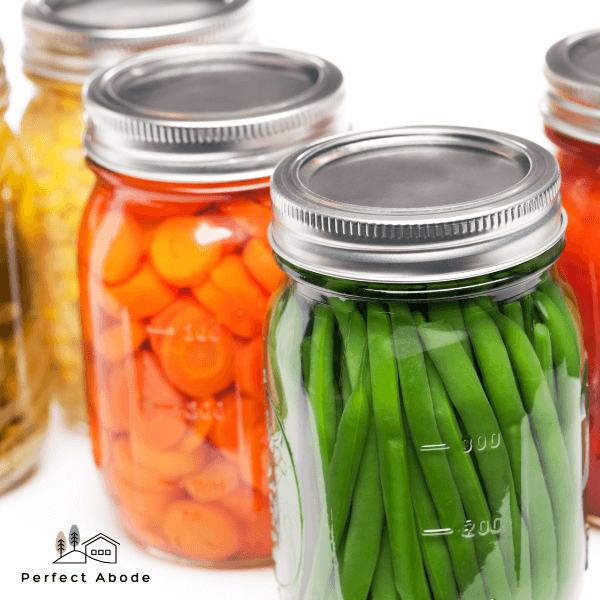
When it comes to organizing your food pantry, having the right storage solutions can make all the difference. Not only do they help you maximize space, but they can also add a touch of creativity and personality to your pantry. In this section, we will explore some amazing DIY, pantry doors and storage ideas that you can easily implement.
Ideas and tutorials for custom storage solutions
- DIY shelving using recycled materials: Instead of buying expensive shelves, why not get creative and build your own using recycled materials? You can use old crates, wooden pallets, or even repurpose bookshelves to create unique and functional storage options.
- Repurposing household items for pantry organization: Look around your house, and you’ll be surprised at the number of items that can be repurposed for pantry organization. Mason jars can be used to store spices, while magazine holders can be used to hold canned goods. Get creative and think outside the box!
Cost-effective organization options
- Utilizing hanging organizers or hooks for additional storage: If you’re running out of space in your pantry, consider using hanging organizers or hooks to create more storage options. Hang baskets on the inside of cabinet doors to store snacks, or use S-hooks to hang pots and pans.
- DIY labeling systems using craft materials or printables: Labels are essential for maintaining an organized pantry. Instead of buying expensive label makers, create your own DIY labels using craft materials or printables. Not only will it save you money, but it will also add a personal touch to your pantry.
By implementing these DIY storage solutions, you can transform the empty space in your food pantry into a well-organized and visually pleasing space. Get creative, have fun, and enjoy the benefits of an organized pantry!
Conclusion
After learning about the various aspects of organizing a food pantry, you are now equipped with the knowledge and tools to transform your pantry into a well-organized space. Let’s recap the key points:
- Start with the basics: declutter and clean your pantry.
- Organize food storage and shelves to maximize space and accessibility.
- Implement an inventory management system to keep track of your supplies.
- Meal planning and preparation can save time and reduce food waste.
- Consider donating excess food to charity to help those in need.
- Use labeling and labeling systems to easily locate items.
- Optimize space by utilizing vertical storage solutions and door space.
- Maintain cleanliness and implement pest control measures regularly.
- Take advantage of bulk buying to save money and ensure pantry stock.
- Implement budgeting and shopping tips to make the most of your grocery trips.
- Create DIY storage solutions to suit your specific pantry needs.
Now it’s time to take action and enjoy the benefits of a well-organized food pantry. By following these tips and techniques, you’ll save time, reduce stress, and have a functional pantry that makes meal preparation a breeze. Don’t wait any longer; start organizing your pantry today and experience the satisfaction of a well-structured storage space.

As a professional in the home and garden industry, I’m passionate about helping people create their perfect abode. With my knowledge of design trends and expert tips, I’m here to help you find the perfect solution for all of your home and garden needs. I’m excited to share my vision and expertise with Perfect Abode!
Let Perfect Abode take the stress out of shopping – we review the best items on the market so you can save time and make the right decision for your home.
I’m an experienced home goods reviewer with a passion for helping people find the perfect products for their home. With my deep knowledge of the home goods industry and comprehensive research, I’m here to provide you with trusted reviews and reliable advice.
From the latest trends to tried-and-true classics, I’m here to help you make your house into the perfect abode.
You can read more on Elizabeth Cwtch at the following places:
https://www.youtube.com/@ElizabethCwtch/about
https://elizabethcwtch.blogspot.com/
https://elizabethcwtch.wordpress.com/
https://en.gravatar.com/elizabethcwtch
https://www.tumblr.com/elizabethcwtch
https://twitter.com/elizabethcwtch
https://www.pinterest.co.uk/elizabethcwtch/
https://www.instagram.com/elizabethcwtch/
https://issuu.com/elizabethcwtch
https://elizabethcwtch.weebly.com/
https://medium.com/@elizabethcwtch
At Perfect Abode, we understand the struggle of finding the perfect products for your home. That’s why we do the hard work for you! We collect the details and review the best items on the market, so you can save time and confidently choose the ideal products for your home. With Perfect Abode, you can trust that you are making the right decision for your home.
Yours Sincerely
Elizabeth x

